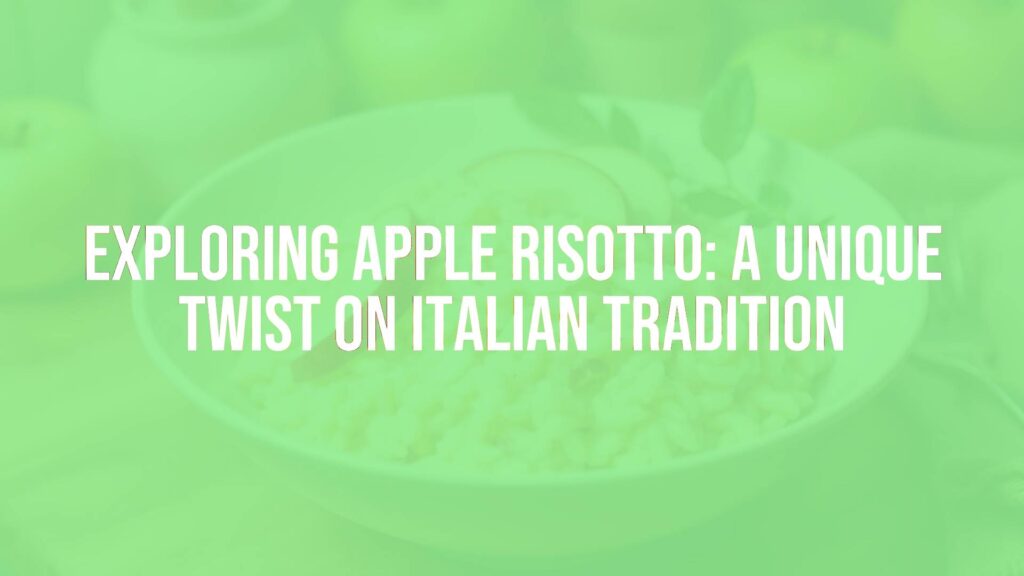Introduction to Apple Risotto
Apple risotto stands out as an innovative example of how Italian cuisine often blends tradition with regional flair. By marrying the creamy essence of classic risotto with the subtle sweetness of apples, this dish offers a fresh take that is both comforting and refined. Apple risotto, or “risotto alle mele,” is notable for its harmonious balance of flavors and aromatic appeal, making it a delightful option for those seeking something distinctive within Italian cooking.
What Makes Apple Risotto Unique?
Unlike the more familiar savory risottos, apple risotto brings together the earthiness of Arborio or Carnaroli rice with the natural sweetness and delicate acidity of apples. The result is a dish with a creamy texture, punctuated by gentle bites of tender apple pieces. Its characteristic flavor profile is layered, weaving together subtle tartness, a hint of floral fruitiness, and the buttery richness imparted by Parmesan cheese and a touch of butter. The visual appeal is enhanced by pale hues, often accented by flecks of golden apple and sometimes fresh herbs.
Historical Background and Regional Significance
While risotto is indelibly linked to Northern Italy—especially Lombardy and Veneto—apple risotto reflects the influence of regions where apple cultivation thrives, such as Trentino-Alto Adige. In these northern provinces, apples are a staple crop, and local cooks have long experimented with incorporating them into both sweet and savory dishes. Though not as ancient as some risotto varieties, apple risotto symbolizes a spirit of adaptability and creativity in the Italian kitchen.
Key Ingredients and Preparation
The essence of apple risotto lies in a few core components:
- Rice: A short-grain variety such as Arborio or Carnaroli, prized for its high starch content and ability to yield a creamy consistency.
- Apples: Crisp, slightly tart apples like Golden Delicious or Granny Smith are commonly selected to provide structure and contrast.
- Broth: Typically, a light vegetable or chicken stock is used to gently coax the grains to softness.
- Onion or Shallot: Provides a delicate base note.
- White Wine: Offers acidity and depth, complementing the apples.
- Parmesan Cheese and Butter: Enrich the finished dish and enhance its creamy texture.
Common Variations and Ingredient Substitutions
Apple risotto can take on many subtle forms. Some cooks introduce fresh herbs, such as thyme or sage, to infuse herbal notes. Others may fold in a handful of toasted walnuts or pecans for added texture and a nutty counterpoint. In vegan or dairy-free adaptations, olive oil replaces butter, and plant-based cheese substitutes or nutritional yeast can stand in for Parmesan. For extra complexity, certain recipes include a splash of apple cider or Calvados during cooking.
Serving Suggestions and Pairings
Apple risotto is fitting as a delicate primo piatto (first course) or an elegant vegetarian main. Its subtle sweetness pairs exceptionally well with roasted poultry, pork tenderloin, or mild cheeses. For beverages, a dry white wine—such as Pinot Grigio or Chardonnay—complements the apple notes without overwhelming the palate. Light, crisp salads dressed with vinaigrette serve as a refreshing contrast on the side.
Conclusion
Apple risotto exemplifies the Italian knack for transforming familiar ingredients into something extraordinary. With its creamy texture, gentle sweetness, and adaptability, it continues to win admirers both in Italy and abroad, offering a delicious way to explore regional traditions with a modern twist.

